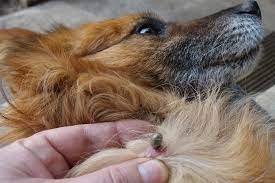Dog ticks are a kind of tick that feeds on dogs, other canids, and various animals, from rodents to farm animals. They are common in North America and are mostly found near forests, grassy fields, and paths.
Dog ticks need three different hosts throughout their life. Baby and young ticks feed on small mammals like mice and rats, while adult ticks prefer animals like raccoons, skunks, cats, and dogs.
In this article, we cover the symptoms of ticks, common diseases they can cause, and treatment options.
Tick bites on dogs can lead to various symptoms, with severity depending on the tick and the illness it carries.
Common symptoms include:
- Fever
- Tiredness
- Loss of appetite
- Swollen lymph nodes
- Stiff joints
- Vomiting
In some cases, ticks can cause seizures or even death. Regularly check dogs for ticks, especially if they spend time outdoors in wooded or grassy areas, and use tick prevention products.
Symptoms of tick diseases might not appear until months after the bite, and the tick may no longer be present. Watch for signs like fever, exhaustion, shifting lameness, pale gums, and trouble breathing. If a dog shows any of these symptoms, take them to a veterinarian for diagnosis and treatment.
Some major tick-borne diseases that affect dogs include Lyme disease, Ehrlichiosis, and Babesiosis.
Lyme disease symptoms may involve fever, lameness, limping, joint pain or swelling, enlarged lymph nodes, and tiredness. It can lead to kidney disease, which could be fatal. Dogs don’t get a “bull’s eye” rash like humans. Lyme disease is typically diagnosed through blood tests, which help vets decide on further testing.
Ehrlichiosis in dogs is found all over the world and is spread by ticks like the Brown Dog Tick, the Lone Star Tick, and the American Dog Tick. Symptoms include fever, lack of appetite, and low blood platelets, often seen as nosebleeds or bruising or anemia signs. These symptoms appear 1-3 weeks after an infected tick bite. Dogs diagnosed and treated quickly have a good chance of recovery, but those who reach the chronic phase have a harder time.
Babesiosis is primarily caused by tick bites but can also spread through dog bites, from mother to unborn puppies, and possibly via contaminated IV blood. The main problem with Babesiosis is “hemolysis,” or the breakdown of red blood cells. Signs include tiredness, pale gums, dark urine, and jaundice (yellow or orange skin or eye whites).
Treatment for tick-borne diseases in dogs depends on the specific disease and symptom severity.
Treatments may include antibiotics, anti-inflammatory medications, and supportive care for symptoms like fever, pain, and tiredness. In some cases, hospitalization with intravenous fluids and medications may be required.
Vectra 3D is a fast-acting topical medication for dogs, protecting against fleas, ticks, mosquitoes, mites, lice, and sand flies. Suitable for dogs and puppies over 7 weeks old, it offers long-lasting protection against disease-causing vectors. Vectra 3D kills ticks upon contact, effectively eliminating four tick species within 24 hours. It also prevents immature tick development. The medication lasts a month, is quick-drying, water-resistant, and non-greasy, and remains effective even after bathing and swimming.
Revolution is an FDA-approved broad-spectrum parasiticide with a well-defined safety profile. Effective for dogs over six weeks old, it kills ticks, controls infestations, eliminates fleas and ear mites, and prevents heartworm disease.
Frontline Plus is the top veterinarian-recommended medication for treating ticks on dogs. Approved for puppies over eight weeks old, it provides long-lasting protection. Frontline Plus is waterproof, effective after swimming and bathing, and works all month long. It breaks the tick lifecycle to prevent future infestations and is effective against various tick species, including the Lyme disease-carrying deer tick.
Final Thoughts
Starting treatment as soon as possible improves recovery chances and prevents more severe disease progression. Regular vet check-ups help detect and treat tick-borne diseases early, increasing the likelihood of successful recovery. Using tick prevention products and regularly checking dogs for ticks, especially after visiting tick-prone areas, is essential.
For more information, visit Pet Meds Online


